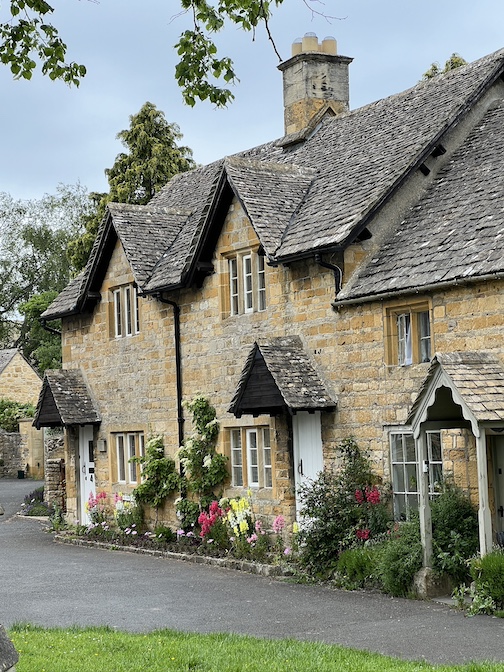The Cotswold surprise would be less if I read more, then I’d know this land was once the land of Wool Barrons and landed gentry.
I’d have known it was the land of Big Wool who carried their fleece to market on ancient Roman roads.
But I like the element of surprise, just not when I’m driving past huge walled estates.
So no driving, and here’s why: It’s impossible.
Today we rolled over roads with a local expert, like yesterday.
I was in the back seat both times.
The difference is today was a roller coaster through towns built in the 1300-1400’s; yesterday felt like a visit from an old friend.
Both had flair.
With similar building materials (stone) creating a unified curb appeal it’s hard to believe the Cotswold towns weren’t part of a planned community.
In the historical progression from boom to bust they were built for the long haul.
With Big Wool money flooding into the region the towns sprung up in unison.
When fortunes turned, they were abandoned.
Then what? They didn’t crumble away.
The Cotswold Surprise
There are some things you shouldn’t do, some things you can’t do, and some you do no matter what.
Driving into the Cotswold countryside?
I like to brag about my driving skills, as they are, which isn’t much.
In fact my confidence is still a little shaken from a car accident two months ago, and I’m working through it, just not on country roads across the rolling Cotswalds.
If I drove the miles I rode along with I’d be the guy on the news who ran out of gas and was never seen again.
Instead, Lizzy drove a Mercedes van into the heart of the Cotswalds.
The Cotswolds are celebrated as the honey-coloured stone heartland of England. Their spectacular backdrop of lush green hills, thatched roofs and quaint country pubs, are so perfectly charming they often seem otherworldly.
The Cotswolds covers a vast area almost 800 square miles in size.
The region runs through five counties (Gloucestershire, Oxfordshire, Warwickshire, Wiltshire and Worcestershire).
But where is the heart of the Cotswolds?
I know, I know.
The heart of the Cotswalds is in the intrepid souls of the people who decided they wanted to live a slower paced life.
Then they get swarmed by tourists. Hey, Oh.
Today’s people living in centuries old houses is hard to imagine, until I saw a woman come out the front door with her dog in 2024 the same way someone else did in 1624.
The Cotswolds is the largest Area of Outstanding Natural Beauty in England. The region’s most famous towns and villages include Bourton-on-the-Water, Burford, Broadway, Chipping Norton, Stow-on-the-Wold, Stroud, and Winchcombe.
But when celebrating the beauty of the Cotswolds your mind is likely to wander to Bibury, the jewel in the Cotswold crown. The beautifully distinctive Arlington Row, with its honey-coloured weavers cottages, is the most iconic Cotswold location.
This 17th-century gem certainly serves as the embodiment of the Cotswolds quintessential English charm and unique beauty. So beautiful is Bibury that William Morris described it as “the most beautiful village in England” in the 1800s.



